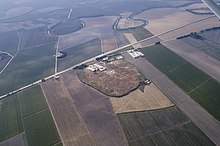
Back تل طعينات Arabic تل طعينات ARZ Tell Tayinat German Tell Tayinat Spanish Tell Tayinat French תל טאיינאט HE Kinalua Hungarian Kinalua Lithuanian Tell Tayinat NB Kinalua Polish
 Tell Tayinat | |
| Location | Hatay Province, Turkey |
|---|---|
| Region | Levant |
| Coordinates | 36°14′51″N 36°22′35″E / 36.24750°N 36.37639°E |
| Type | Settlement |
| History | |
| Periods | Early Bronze Age, Early Iron Age |
| Cultures | Neo-Hittite, Aramean |
| Site notes | |
| Excavation dates | 1935-1938, 2003-present |
| Archaeologists | Robert Braidwood, Timothy Harrison |
| Condition | In ruins |
Tell Ta'yinat is a low-lying ancient tell on the east bank at the bend of the Orontes River where it flows through the Amuq valley, in the Hatay province of southeastern Turkey about 25 kilometers south east of Antakya (ancient Antioch), and lies near Tell Atchana, the site of the ancient city of Alalakh. Tell Ta'yinat has been proposed as the site of Alalaḫu, inhabited in late 3rd millennium BC, mentioned in Ebla's Palace G archive;[1] and in later times as Kinalua, the capital city of an Iron Age Neo-Hittite kingdom.[2] Among the findings are an Iron Age temple and several 1st millennium BC cuneiform tablets.[3] Chatal Huyuk (Amuq) is another major site that is located in the area.[4]
- ^ Welton, Lynn, (2020). "Northern Levantine spheres of interaction: The role of the 'Amuq plain in the Late Chalcolithic and Early Bronze Age", in: Melissa Kennedy (ed.), A Land in Between: The Orontes Valley in the Early Urban Age, Sydney University Press, p. 37: "...During the period of the Palace G archive [in Ebla], the site of Tell Tayinat may be identified with references to Alalaḫu, representing the major centre of the 'Amuq plain during this period..."
- ^ Welton, L., Harrison, T., Batiuk, S., Ünlü, E., Janeway, B., Karakaya, D., Lipovitch, D., Lumb, D. and Roames, J., "Shifting Networks and Community Identity at Tell Tayinat in the Iron I (ca. 12th to mid 10th Cent. BCE)", American Journal of Archaeology. Vol. 123, pp. 291–333, April 2019.
- ^ Jacob Lauinger, "Some Preliminary Thoughts on the Tablet Collection in Building XVI from Tell Tayinat" Archived 2020-08-19 at the Wayback Machine, Journal (The Canadian Society for Mesopotamian Studies), Vol.6, pp. 5-14, 2011.
- ^ A map of Amuq valley during the Bronze Age with the locations of major archaeological sites. by S. Batiuk - researchgate.net; in Pucci, Marina (2023). "Storage and Food Control in the 'Amuq from the Late Bronze to the Iron Age: The Archaeological Evidence". Studia Asiana. Vol. 13. Florence: Firenze University Press. pp. 161–176. doi:10.36253/979-12-215-0042-4.10. ISBN 979-12-215-0042-4.
